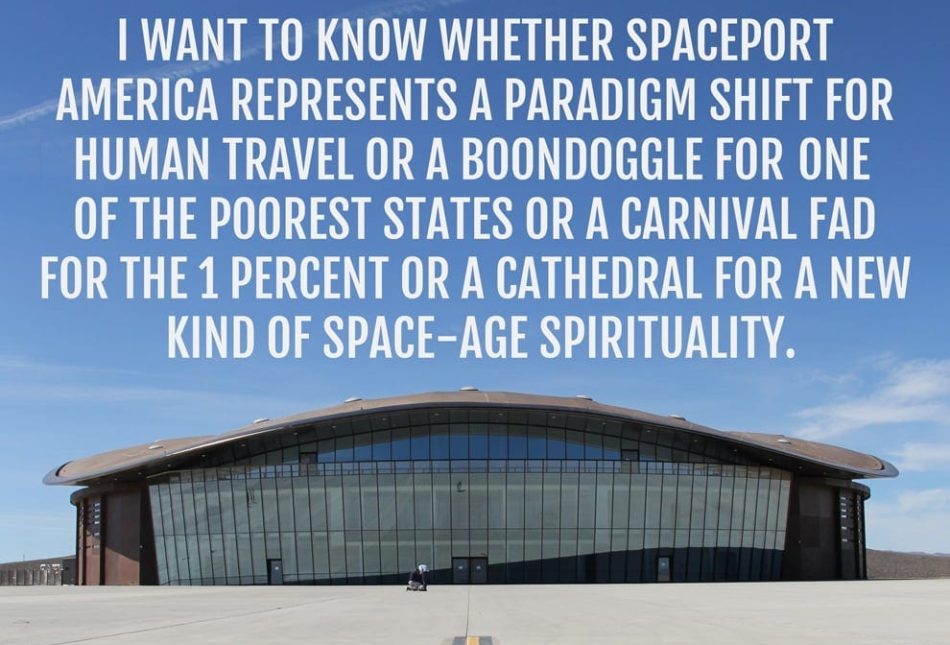Time’s up for Spaceport America

![]()
The irrational belief that a bad investment will, one day, pay off, if we just hold on a little longer, has led to plenty of sorrow in the private sector. In the public sector, though, it’s taxpayers who are victimized when bureaucrats and elected officials refuse to walk away from failed projects once hailed as “economic development.”
“Spaceport America” is probably New Mexico’s worst example of the sunk-cost fallacy. The facility broke ground in June 2009 and “opened” in October 2011. Its “anchor tenant” is Virgin Galactic. Owned by U.K. mega-mogul Richard Branson (net worth, according to Forbes: $5.1 billion), the company aims to send tourists on brief, suborbital trips into space.
Virgin Galactic once hoped to launch their first customers as soon as 2008. Almost a decade later, no tourists have soared into the wild black yonder from New Mexico. And despite regular promises that other firms will soon make use of the spaceport, activity there remains essentially nil.
The facility’s dismal performance is a bitter pill for the Land of Enchantment’s taxpayers. It was built with hundreds of millions of dollars in borrowing, made possible by the state’s severance tax and a special gross receipts tax imposed on Doña Ana and Sierra counties. Of nearly $12 million in expenses in the 2016 fiscal year, less than 19 percent was covered by rent and user fees.
That left taxpayers to pick up the tab for the rest of the costs — including some extremely generous salaries and benefits for “managers” who have very little to do.
So are the spaceport’s officials ready to acknowledge their failure and unload the state’s terminally ill white elephant? Hardly — they’re looking to double down. During a recent televised forum hosted by KRWG in Las Cruces, Dan Hicks, the new CEO of the facility, averred that the “future of Spaceport America is so bright.” He’s seeking more funding for a freight-rail connection, another runway and a payload-processing facility.
Hicks wants his employer “to be able to compete on a national level.” To that end, it’s worth noting that Spaceport America’s competitors spend far less, and ask taxpayers to bear much smaller burdens.
The “Oklahoma Air & Space Port,” located in Burns Flat, was licensed by the FAA in 2006. It’s received more than $7 million in state appropriations, and handed $18 million in tax breaks to a now-bankrupt launch company. So its paltry results have been similar to New Mexico’s — at a fraction of the cost.
Spaceport America claims that SpaceX, Elon Musk’s amazingly successful start-up, is one of its tenants. But the company is “partnering” with the State of Texas and the City of Brownsville, who have ponied up $20 million worth of incentives, to build a launch facility along the Gulf Coast. While the subsidies aren’t needed and shouldn’t be appropriated, SpaceX has committed to spending far more than what taxpayers are being asked to contribute: $85 million.
Other budding spaceports are located in California, Florida, Alabama, Georgia, Canada and New Zealand. While plans for the facilities are fluid, it does not appear that many, if any, are as deeply committed to spending public dollars as Spaceport America. With more natural advantages — coastal locations, capable workforces, marketing to firms with less-risky launch technologies — they don’t have to.
Former Gov. Bill Richardson once claimed that Spaceport America would make southern New Mexico “a pioneer in the private space industry.” That hasn’t happened, and there’s no evidence that it will happen anytime soon. The costs to build and “operate” the spaceport so far have been sunk. Unfortunately, they’re not likely to resurface.
If the spaceport’s officials, and the politicians who fund them, can’t make the facility self-sustaining, it is time for the state to auction it off and reclaim whatever dollars it can for an investment gone horribly wrong.
D. Dowd Muska is research director for New Mexico’s Rio Grande Foundation, an independent, nonpartisan, tax-exempt research and educational organization dedicated to promoting prosperity for New Mexico based on principles of limited government, economic freedom and individual responsibility.

